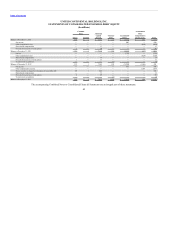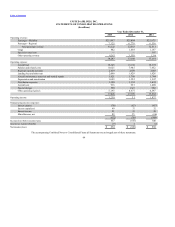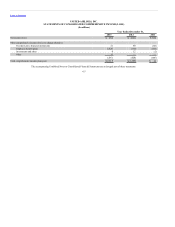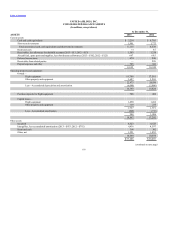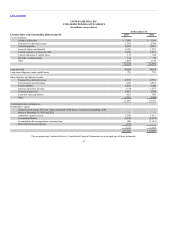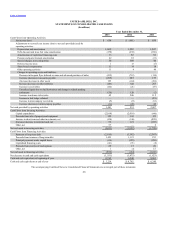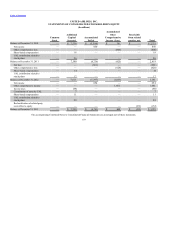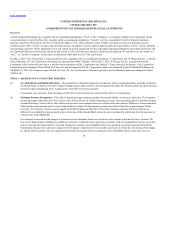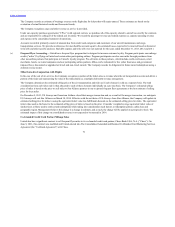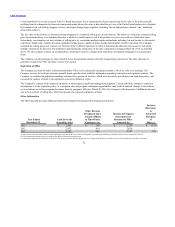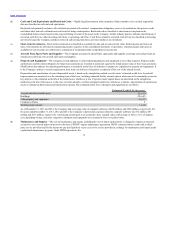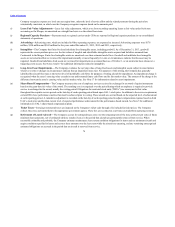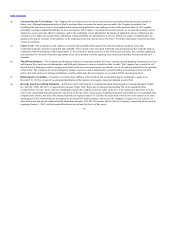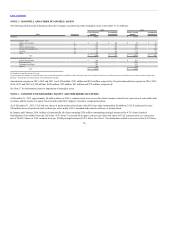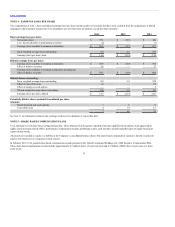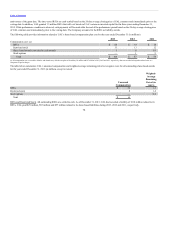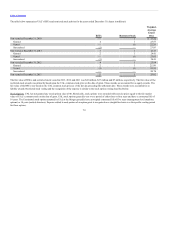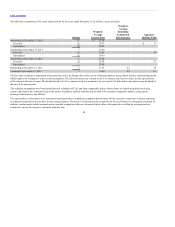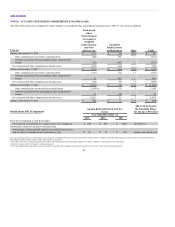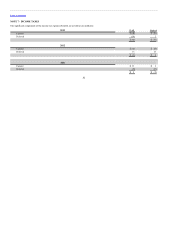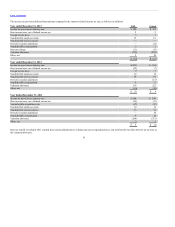United Airlines 2013 Annual Report Download - page 73
Download and view the complete annual report
Please find page 73 of the 2013 United Airlines annual report below. You can navigate through the pages in the report by either clicking on the pages listed below, or by using the keyword search tool below to find specific information within the annual report.
Table of Contents
(d) Highly liquid investments with a maturity of three months or less on their acquisition
date are classified as cash and cash equivalents.
Restricted cash primarily includes cash collateral associated with workers’ compensation obligations, reserves for institutions that process credit
card ticket sales and cash collateral received from fuel hedge counterparties. Restricted cash is classified as short-term or long-term in the
consolidated balance sheets based on the expected timing of return of the assets to the Company. Airline industry practice includes classification of
restricted cash flows as either investing cash flows or operating cash flows. Cash flows related to restricted cash activity are classified as investing
activities because the Company considers restricted cash arising from these activities similar to an investment.
(e) Short-term investments are classified as available-for-sale and are stated at fair value. Realized gains and losses on
sales of investments are reflected in nonoperating income (expense) in the consolidated statements of operations. Unrealized gains and losses on
available-for-sale securities are reflected as a component of accumulated other comprehensive income/loss.
(f) The Company accounts for aircraft fuel, spare parts and supplies at average cost and provides an
obsolescence allowance for aircraft spare parts and supplies.
(g) The Company records additions to owned operating property and equipment at cost when acquired. Property under
capital leases and the related obligation for future lease payments are recorded at an amount equal to the initial present value of those lease payments.
Modifications that enhance the operating performance or extend the useful lives of airframes or engines are capitalized as property and equipment. It
is the Company’s policy to record compensation from delays in delivery of aircraft as a reduction of the cost of the related aircraft.
Depreciation and amortization of owned depreciable assets is based on the straight-line method over the assets’ estimated useful lives. Leasehold
improvements are amortized over the remaining term of the lease, including estimated facility renewal options when renewal is reasonably assured at
key airports, or the estimated useful life of the related asset, whichever is less. Properties under capital leases are amortized on the straight-line
method over the life of the lease or, in the case of certain aircraft, over their estimated useful lives, whichever is shorter. Amortization of capital lease
assets is included in depreciation and amortization expense. The estimated useful lives of property and equipment are as follows:
Aircraft and related rotable parts 25 to 30
Buildings 25 to 45
Other property and equipment 4 to 15
Computer software 5
Building improvements 1 to 40
As of December 31, 2013 and 2012, the Company had a carrying value of computer software of $290 million and $302 million, respectively. For
the years ended December 31, 2013, 2012 and 2011, the Company’s depreciation expense related to computer software was $72 million, $81
million and $133 million, respectively. Aircraft and aircraft parts were assumed to have residual values with a range of 10% to 11% of original
cost, depending on type, and other categories of property and equipment were assumed to have no residual value.
(h) The cost of maintenance and repairs, including the cost of minor replacements, is charged to expense as incurred,
except for costs incurred under our power-by-the-hour (“PBTH”) engine maintenance agreements. PBTH contracts transfer certain risk to third-
party service providers and fix the amount we pay per flight hour or per cycle to the service provider in exchange for maintenance and repairs under
a predefined maintenance program. Under PBTH agreements, the
73


